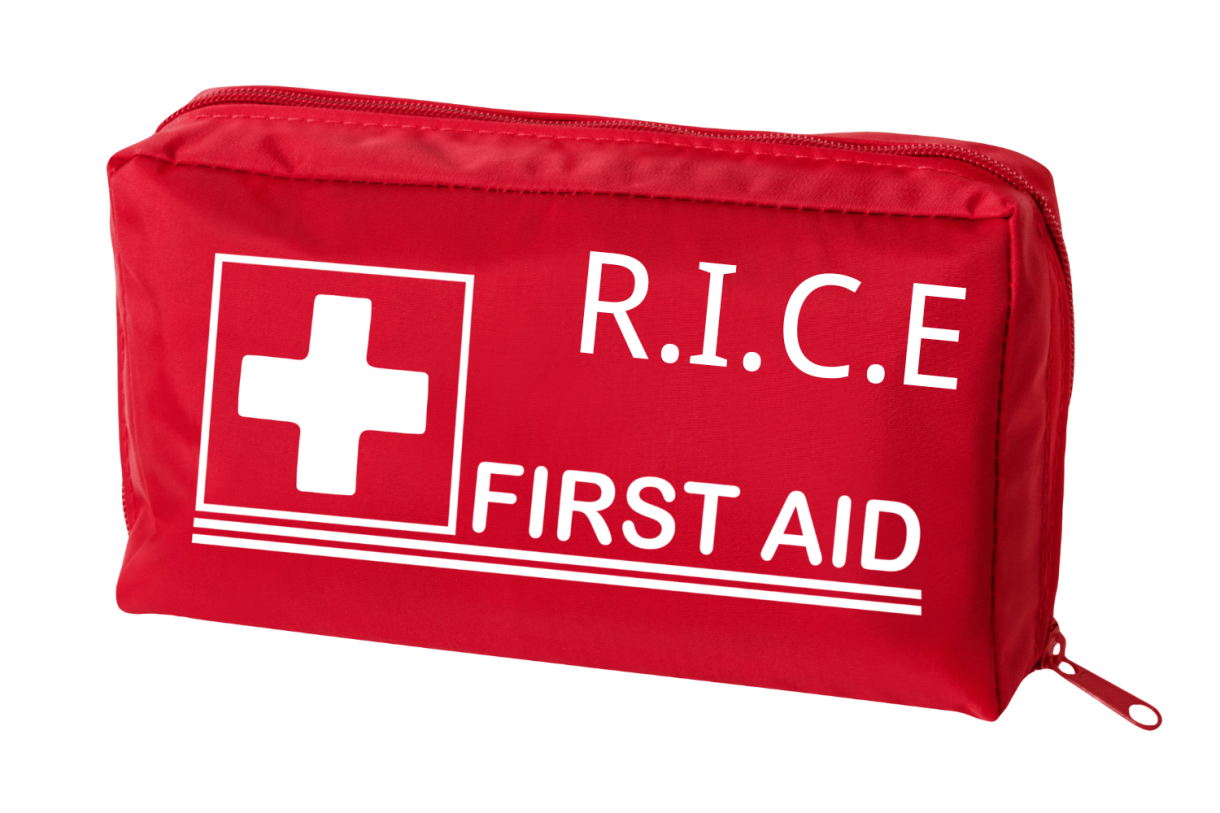
Injuries like sprains, strains, and bruises are common, whether you’re playing sports, working out, or simply going about your day. Knowing how to respond quickly can make a big difference in reducing pain, swelling, and recovery time.
That’s where the R.I.C.E. method comes in. R.I.C.E stands for Rest, Ice, Compression, and Elevation. It’s a simple, effective first-aid technique for treating soft-tissue injuries. By following these steps, you can help manage the injury and prevent further damage.
In this article, we’ll break down what each step of R.I.C.E. means, explain why it’s essential, and show you how to apply it in real-life situations.
What is R.I.C.E. in First Aid?
R.I.C.E. in first aid stands for Rest, Ice, Compression, and Elevation. It’s a simple, effective technique for treating minor soft-tissue injuries, such as sprains, strains, and bruises.
First, rest: stop using the injured area to prevent further damage. Next, apply an ice pack to reduce swelling and pain. Then, Compression: wrap the area with a bandage to minimize swelling. Finally, Elevation: raise the injured limb above heart level. This order helps manage pain and swelling immediately after an injury.
Learning and applying the R.I.C.E. method is essential for basic first aid and is often taught in training courses to manage common injuries effectively.
Now, let’s break down what each letter represents and why this process is so helpful.
Detailed Breakdown of R.I.C.E
The R.I.C.E. method refers to Rest, Ice, Compression, and Elevation. This sequence is a widely used first-aid treatment for acute soft-tissue injuries such as sprains and strains. Below is a detailed explanation of each component.
1. Rest
Rest is crucial immediately following an injury because it prevents further damage and allows the body’s natural healing process to begin. When you stop using the injured area, you reduce stress on damaged tissues. Continued activity can worsen a minor strain or sprain, leading to more pain, swelling, and a longer recovery time.
To properly rest an injury:
- Stop the Activity: Immediately cease the activity that caused the injury.
- Immobilize the Area: Avoid putting weight on or using the affected limb. For example, if you sprain your ankle, stay off your feet as much as possible for the first 24-48 hours.
- Use Support if Needed: Crutches for a leg injury or a sling for an arm injury can help keep the area immobilized and protected from additional strain.
Studies show that protecting an injured area from further stress in the initial hours is vital. This period of rest helps limit internal bleeding and swelling at the injury site, setting a better foundation for healing.
2. Ice
Applying ice is a key step for reducing pain and swelling. Cold therapy, or cryotherapy, constricts blood vessels, helping limit swelling and inflammation after an injury. It also has a numbing effect that provides immediate pain relief. An inflamed, swollen area can cause significant discomfort and delay healing.
When applying ice, follow these steps:
- Apply Ice Promptly: Use a cold pack, a bag of frozen vegetables, or ice cubes wrapped in a towel as soon as possible after the injury.
- Protect the Skin: Never apply ice directly to the skin, as this can cause frostbite. Always use a barrier, such as a thin towel.
- Follow the 20-Minute Rule: Apply the ice for 15-20 minutes at a time, then remove it for at least 20 minutes to allow the skin to return to a normal temperature. Repeat this cycle several times throughout the day for the first 48 hours.
Using ice effectively helps control the inflammatory response. This simple step can significantly reduce pain and limit the swelling that often accompanies sprains and strains, making the injury more manageable.
3. Compression
The "C" in R.I.C.E. stands for Compression, which is the third step after rest and ice. Applying pressure to an injured area helps to limit swelling and provides support. When tissues are damaged, fluid can leak into the surrounding area, causing swelling. Compression helps prevent this fluid buildup.
To apply compression correctly, use an elastic bandage. Wrap the bandage firmly around the injured area, starting a few inches below the injury and moving upward. The wrap should be snug but not so tight that it cuts off circulation. Signs of a too-tight wrap include numbness, tingling, or increased pain. The bandage provides gentle, even pressure that physically restricts how much the area can swell.
Effective compression can make a noticeable difference in recovery. Studies have shown that combining compression with ice is more effective at reducing swelling than using ice alone. This highlights the importance of using a compression wrap as part of the initial treatment for sprains and strains.
4. Elevation
Finally, the "E" in R.I.C.E. stands for Elevation. This step involves raising the injured limb above your heart. The goal of elevation is to use gravity to help drain excess fluid away from the injury site, further reducing swelling and pain.
To elevate an injury, prop the affected limb up on pillows or cushions. For an ankle or knee sprain, lie down with your leg raised. For an arm or wrist injury, you can use a sling and prop your arm on pillows while sitting or lying down. This should be done as often as possible during the first 24-48 hours.
Proper elevation can significantly impact recovery time. By minimizing swelling, you reduce pressure on the nerves, thereby alleviating pain. This simple, non-invasive technique works alongside rest, ice, and compression to create the optimal environment for your body to heal.

Detailed Breakdown of R.I.C.E
How to Practically Apply R.I.C.E
When you treat a common injury, such as a sprain or strain, with the R.I.C.E. method, you follow a structured approach to manage pain and swelling. Here’s how you do it:
1. Assessing the Injury
Before applying R.I.C.E., it’s crucial to assess the injury. First, ensure the area is safe. Next, look at the injured limb. Is there an obvious deformity, a break in the skin, or severe pain? These could signal a more serious injury, like a fracture, that requires professional medical attention. If the injury appears to be a minor sprain or strain—characterized by swelling, bruising, and pain—you can proceed with the R.I.C.E. method. For example, if someone twists their ankle playing sports and it starts to swell, R.I.C.E. is the appropriate first aid response.
2. Initiating R.I.C.E.
Initiating the R.I.C.E. method is crucial for responding effectively to soft tissue injuries. Here’s how you can start: When someone sustains an injury like a bruised knee, begin the R.I.C.E. sequence promptly:
- Rest: Have the person stop all activity and sit or lie down to take weight off the injured knee.
- Ice: Apply a cold pack wrapped in a towel to the knee for 15-20 minutes to reduce swelling and numb the pain.
- Compression: Gently wrap the knee with an elastic bandage to help limit swelling. Ensure it’s snug but not cutting off circulation.
- Elevation: Prop the leg up on pillows so the knee is above heart level. Continue this process, especially for the first 24-48 hours. This method prioritizes controlling inflammation early on, which is vital for a quicker recovery.
3. Transition to Professional Care
After you’ve started applying R.I.C.E., it’s essential to monitor the injury. While R.I.C.E. is effective for minor injuries, some situations require a transition to professional medical care. If the pain or swelling gets worse after 48 hours, or if the person is unable to put any weight on the limb, it’s time to see a doctor. When you seek medical help, inform the healthcare provider what steps you’ve taken, including when the injury occurred and how you’ve been applying the R.I.C.E. method. This information helps them make an accurate diagnosis and create a treatment plan. Even if the injury seems to be improving, a follow-up with a doctor or physical therapist can be beneficial to ensure proper healing and prevent reinjury.
4. Differences for Various Body Parts
Applying R.I.C.E. means making small changes depending on the location of the injury:
- Ankle/Knee: These injuries are common. Elevation is key, so lie down and prop the leg up on several pillows. A compression wrap is very effective here to control the significant swelling that can occur.
- Wrist/Elbow: For arm injuries, a sling can help with the "Rest" component by immobilizing the area. When sitting or lying down, you can use pillows to elevate the arm above heart level. Applying ice and a compression wrap follows the same principles. These adjustments ensure you apply R.I.C.E. effectively based on the specific needs of the injured area, helping to speed up recovery until you can get professional advice.
When Not to Use R.I.C.E
The R.I.C.E. method is a standard first-aid treatment for minor soft-tissue injuries. However, there are certain situations when it may not be appropriate, or when it should be stopped in favor of immediate medical attention.
1. Obvious Fractures or Deformities
If you suspect a severe fracture, which may be indicated by an obvious deformity, bone protruding through the skin, or an inability to move the limb at all, do not use the R.I.C.E. method. Applying compression or trying to elevate the limb could cause more damage and severe pain.
Such injuries require immediate professional medical care. Focus on keeping the person calm and still until emergency services arrive. Trying to manage it with R.I.C.E. can worsen the injury.
2. Open Wounds or Severe Bleeding
When an injury involves an open wound, severe bleeding, or exposed tissue, R.I.C.E. is not the priority. Applying ice or a compression wrap directly over a deep cut can interfere with proper wound care and increase the risk of infection.
The primary focus should be on controlling the bleeding by applying direct pressure with a clean cloth and seeking immediate medical help. Wound management takes precedence over treating a sprain or strain.
3. Signs of a Dislocation
A dislocation occurs when a bone is forced out of its joint, often causing intense pain, swelling, and an inability to move the joint. While some symptoms overlap with a sprain, a visibly out-of-place joint is a clear sign of a dislocation.
Do not attempt to apply R.I.C.E. or move the joint back into place yourself. This can damage nerves, blood vessels, and ligaments. The priority is to immobilize the joint as best as you can and get to an emergency room immediately for professional medical treatment.
4. Loss of Sensation or Circulation
If the injured person reports numbness, tingling, or a "pins and needles" sensation, or if the skin below the injury feels cold or turns blue, this could indicate nerve damage or a compromised blood supply. These are serious signs that require urgent medical evaluation.
Applying a compression wrap in this situation could further restrict blood flow and worsen the problem. Do not use R.I.C.E. and seek emergency medical care right away to prevent permanent damage.
5. Head, Neck, or Spine Injuries
The R.I.C.E. method is designed for limb injuries, not injuries to the head, neck, or back. If you suspect someone has sustained an injury to these critical areas, do not move them. Applying ice or compression is not appropriate and can be dangerous.
In these situations, the most important action is to call for emergency medical services immediately and keep the person as still as possible until help arrives. Any movement could lead to paralysis or more severe injury.
6. When in Doubt, Seek Medical Care
If you are unsure about the severity of an injury, it is always best to err on the side of caution. R.I.C.E. is for minor sprains and strains. If the pain is severe, the person cannot bear weight on the limb, or the swelling is extreme, it's time to see a doctor.
Delaying professional medical care for a more serious injury can lead to complications and a longer, more difficult recovery. It's better to get it checked out.
7. Pre-existing Medical Conditions
For individuals with certain medical conditions, such as diabetes, peripheral artery disease (PAD), or Raynaud's phenomenon, applying ice or compression can be risky. These conditions can affect circulation and sensation, and cold therapy or tight wraps could cause tissue damage.
In these cases, it is best to consult a doctor before using the R.I.C.E. method. They can provide guidance on safely managing an injury, taking the person’s overall health into account.
Be Prepared to Handle Injuries with R.I.C.E
Understanding the R.I.C.E. method is very important if you need to provide first aid for common injuries. Starting with rest and ice can really help manage pain and swelling. Remembering the steps—Rest, Ice, Compression, Elevation—can make a big difference in recovery. It’s good to practice and stay informed about first aid techniques. Whether you’re at home, work, or on the sports field, knowing how to apply R.I.C.E. can prevent further injury and speed up healing. Stay informed, keep your first aid knowledge fresh, and be ready to help when someone needs it. You could make a massive difference by knowing what to do.








 Login with Google
Login with Google Login with Facebook
Login with Facebook